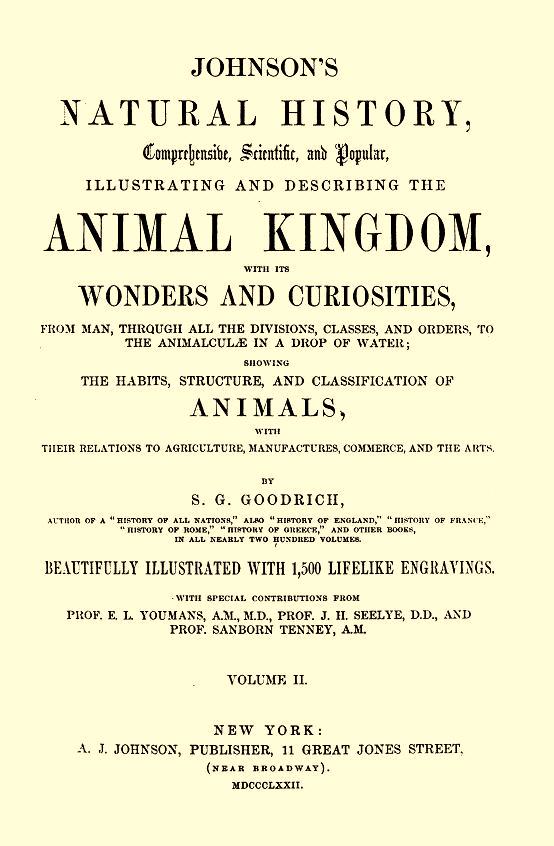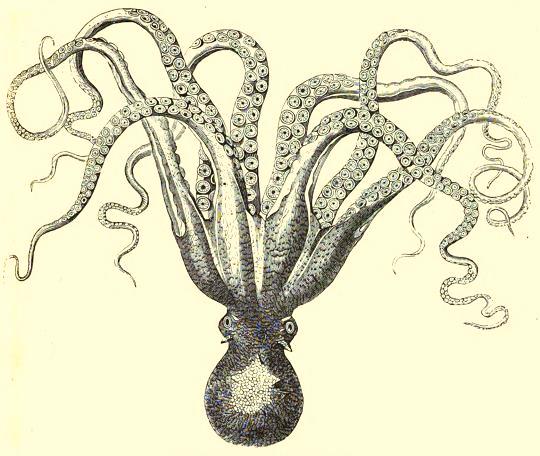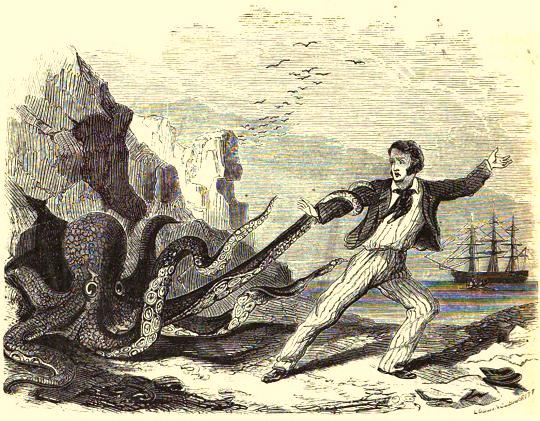|
  |
. . . .
Genus OCTOPUS: Octopus. — This includes the Eight-armed Cuttle-Fish, O. vulgaris, anciently called Polypus, which has been abbreviated into the popular title Poulpe. It has no shell, and no skeleton, but has two conical pieces of horny substance imbedded in the back, one on each side. The body, which has a globular form, is a soft, jelly-like substance, covered with a thick, dark-colored, leathery skin. The arms or legs are eight in number, and are very long, sometimes having an expanse of five feet; but even in a specimen of this size, the head and body would not be over a foot long. The animal moves with its head either up or down; when it walks on the ground or on the bottom of the sea, it is in the latter position. (See p. 498.) The arms are each furnished with one hundred and twenty pairs of sucking-cups, making nearly two thousand in all; by means of these they are able to maintain a powerful grasp upon their prey; indeed the arms may sooner be wrenched off than forced to loose their hold. If, however, they are thus torn asunder, they are soon replaced by spontaneous growth. The arms of this species are esteemed good food by some of the people around the Mediterranean, where it is common. The eye of the cuttle-fish is large and exceedingly keen-sighted; the whole body of the creature is phosphorescent in the dark, and the eyes shine like those of a cat. The mouth is placed in the space inclosed by the arms; it consists of a thick circular lip around an orifice; beneath this lip, and partially appearing through the orifice, is a beak like that of a parrot, excepting that the short mandible is the uppermost; these mandibles do not cover bone, but their interior is filled with a fibrous substance of great strength and solidity. The muscles in which |
 the poulpe or eight-armed cuttle-fish.
the jaws are imbedded, and by which they are worked, are extremely powerful; the jaws are, in fact, capable of stripping off the armor from crabs and lobsters, and of cutting up the flesh of fishes. Within the mandibles is a fleshy tongue, invested with a papillose membrane of delicate texture, and also armed with recurved horny papillae, so that the tongue by its vermiform action, is easily enabled to transmit the food into the gullet, which passes through a ring in the cranial cartilage, dilates into a spacious crop with glandular walls, whence a short canal leads to a strong, muscular gizzard, lined with a leathery skin. In this gizzard the food is ground to pulp. In addition to its other extraordinary endowments, the cuttle-fish is supplied with an inkbag enfolded in the mass of the liver, containing the substance called sepia, and formerly used, it is said, by the Chinese, in making Indian-ink. The creature has the power of ejecting this through its siphons placed on the left side of the abdomen, so as to render it an effectual means of defense. Powerful as it is, however, for the destruction of various kinds of sea animals, it has enemies superior in strength to itself, such as the grampus, the cachalot, &c. When its quick eyes perceive one of these huge monsters approaching, it ejects a quantity of its inky fluid into the water, which immediately spreads around into a dark cloud; while the enemy is floundering about, bewildered and astonished, in this murky fog, the nimble cuttle darts away and conceals himself in the mud at the bottom, or the safe fissure of some neighboring rock. The use of this ink-battery as a means alike of defensive and offensive warfare, is evinced by an anecdote of a British officer, who on a certain occasion, had gone ashore to collect shells, happening to be attired in a pair of snow-white pantaloons. As he was walking about, he suddenly came upon a cuttle-fish, snugly harbored in the recess of a rock. For a moment the two stared a |
 mr. beale and the poulpe.
each other with mutual surprise; after a time the officer advanced a little, when, quick as thought, the poulpe discharged a spray of ink, and taking good aim at the snowy pants, spattered them with indelible stains, which rendered them, ever after, unpresentable. This species seems to be widely distributed in almost all seas. In the North Atlantic it is usually of small size, but in the Mediterranean it is sometimes so large as to weigh a hundred pounds; the body of one has been seen of the size of a barrel, and with arms as thick as those of a man. In the tropical seas they are said to be much larger, and so fierce as sometimes to attack boats and drag them under water. We are told that in the Indian waters, such things have actually happened, and in certain localities the boatmen always keep themselves supplied with axes to cut off the arms of these monsters, in case of an attack. Their remarkable spirit, as well as their strength, is evinced by an adventure which Mr. Beale, an Englishman, had with one of them among the rocks of the Bonin Islands, where he had gone ashore to seek for shells. As he was moving about, he was suddenly arrested by seeing at his feet a most extraordinary looking animal, crawling toward the surf, which it had only just left. It was creeping on its eight legs, which, from their soft and flexible nature, bent considerably under the weight of its body, so that it was lifted by the efforts of its tentacula only a small distance from the rocks. It appeared much alarmed at seeing him, and made every effort to escape. Mr. Beale endeavored to stop it by pressing on one of its legs with his foot; but, although he used considerable force for that purpose, its strength was so great that it several times liberated its member in spite of all the efforts he could employ on the wet and slippery rocks. He then laid hold on one of the tentacles with his hand and held it firmly, so that it appeared as if the limb would be torn asunder by the united efforts of himself and the creature. He then gave it a powerful jerk, wishing to disengage it from the rocks to which it clung so forcibly by its suckers. This effort it effectually resisted; but the moment after, the apparently enraged animal lifted its head with its large projecting eyes, and loosing its hold of the rocks, suddenly sprang upon Mr. Beale's |
arm, and clung to it by means of its suckers with great power, endeavoring to get its beak, which could now be seen between the roots of its arms, in a position to bite. A sensation of horror pervaded his whole frame, when he found that this hideous animal had fixed itself so firmly on his arm. Its cold, slimy grasp was extremely sickening; and he loudly called to the captain, who was at some distance, to come and release him from his disgusting assailant. The captain quickly came, and taking him down to the boat, during which time Mr. Beale was employed in keeping the beak of the octopus away from his hand, soon released him, by destroying his tormentor with the boat-knife, which he accomplished by cutting away portions at a time. There are several other species of this genus;, among them is the 0. moschatus, found in the Mediterranean, and having a strong musky smell. The species of the genus Eledone, have only a single row of suckers on each arm. In these the head and body are even shorter and rounder than in the 0. vulgaris. . . . .
|
|
Source.
Samuel Griswold Goodrich.
This transcription was made from the volume at the Hathi Trust.
Last updated by Tom Tyler, Denver, CO, USA, Nov 12 2022
|
|